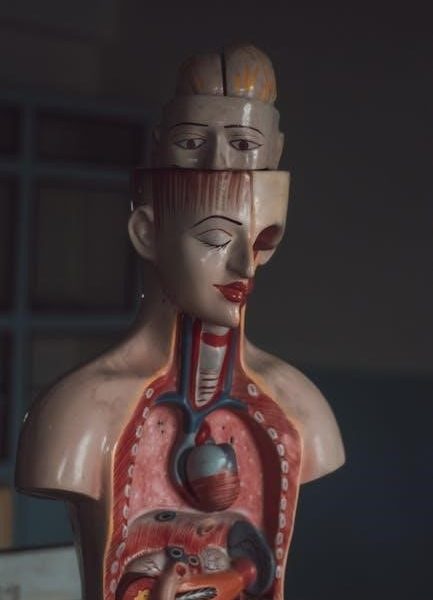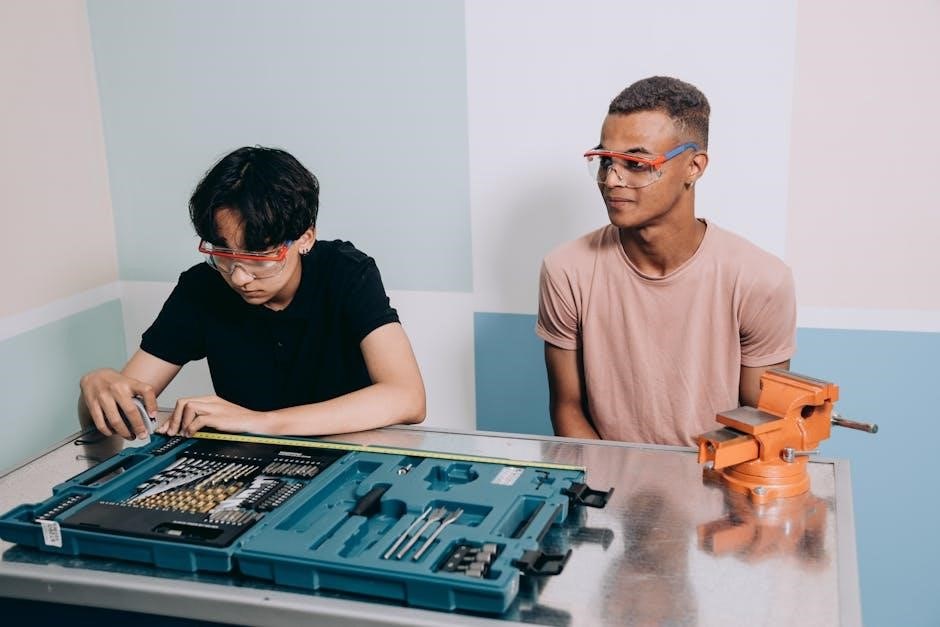The Human Anatomy and Physiology Lab Manual, 13th Edition, is a comprehensive guide for hands-on learning, featuring updated visuals and clinical applications. Authored by Elaine Marieb and Lori Smith, it enhances student engagement with interactive resources and critical thinking exercises, perfect for both laboratory and non-laboratory settings.
1.1 Overview of the Manual
The Human Anatomy and Physiology Lab Manual, 13th Edition, provides a comprehensive, hands-on approach to studying the human body. Designed for both laboratory and non-laboratory settings, it includes updated visuals, clinical applications, and critical thinking exercises. This edition emphasizes interactive learning, making it ideal for students seeking a deeper understanding of anatomical and physiological concepts through practical exploration and real-world scenarios.
1.2 Key Features of the 13th Edition
The 13th Edition of the lab manual includes new full-color figures and photos in review sheets, enhanced clinical application questions, and critical thinking exercises. It integrates seamlessly with digital resources like Mastering A&P, offering interactive 3D models and simulations. The manual also features updated hands-on activities, problem-solving exercises, and ethical considerations, making it a versatile tool for both laboratory and non-laboratory learning environments.
1.3 Importance of Laboratory Study in Anatomy and Physiology
Laboratory study is crucial for understanding anatomy and physiology, as it provides hands-on experience and reinforces theoretical concepts. By engaging in practical exercises, students develop observation and analytical skills, essential for careers in healthcare. The lab manual’s interactive approach ensures active learning, helping students grasp complex processes and apply knowledge to real-world scenarios, making it indispensable for effective science education.

Structure and Organization of the Manual
The manual is logically organized, starting with foundational concepts and progressing to complex topics. It includes hands-on activities, enhanced visuals, and integration with digital tools for a seamless learning experience.
2.1 Anatomical and Physiological Terminology
The manual begins with a thorough introduction to anatomical and physiological terminology, ensuring students grasp foundational terms and concepts. It includes detailed review sheets with full-color figures and photos to aid understanding. The terminology is presented in a logical progression, from basic to advanced, covering cells, tissues, and organ systems. Hands-on activities reinforce these concepts, while clinical application questions encourage critical thinking and practical application of the terminology in real-world scenarios.
2.2 Hands-On Activities and Experiments
The 13th Edition provides a wide range of hands-on activities and experiments to engage students in active learning. These exercises cover histology, organ dissection, and physiological measurements, reinforcing key concepts. Activities are designed to help students explore complex processes, such as muscle contraction and nerve impulses, through practical observation and experimentation. The manual also includes clinical correlations to connect lab work with real-world applications, enhancing both understanding and retention of anatomical and physiological principles.
2.3 Integration with Digital Resources
The 13th Edition seamlessly integrates with digital resources, enhancing learning through Mastering A&P, Pearson’s online platform. Interactive 3D models, virtual lab simulations, and online quizzes provide a dynamic learning experience. These tools reinforce textbook content, allowing students to explore complex anatomical structures and physiological processes in depth. The integration of digital media with hands-on activities ensures a well-rounded educational experience, catering to diverse learning styles and preferences.

Core Topics Covered in the Manual
The manual covers essential topics like cellular and tissue structure, skeletal, muscular, and nervous systems, as well as cardiovascular, respiratory, and digestive systems in detail.
3.1 Cellular and Tissue Structure
The manual provides a detailed exploration of cellular and tissue structure, starting with basic microscopy techniques. It includes histology slides and hands-on activities to identify cell types and tissue layers. Students learn to distinguish between epithelial, connective, muscle, and nervous tissues through interactive labs and high-quality images. This section also covers the ultrastructure of cells and the importance of tissue organization in maintaining organ function, with clinical correlations to real-world applications.
3.2 Skeletal, Muscular, and Nervous Systems
The manual offers a detailed exploration of the skeletal, muscular, and nervous systems through hands-on activities. Students examine bone structure, muscle anatomy, and nerve histology using dissection and microscopy. Interactive labs include identifying skeletal landmarks, testing muscle function, and tracing nerve pathways. Clinical applications highlight the interplay between these systems, such as reflex responses and movement mechanisms, providing a comprehensive understanding of their integrated functions in the human body.
3.3 Cardiovascular, Respiratory, and Digestive Systems
The manual delves into the cardiovascular, respiratory, and digestive systems through practical investigations. Hands-on exercises include blood pressure measurement, lung capacity testing, and digestion simulations. Detailed illustrations and histology slides enable students to explore organ structures. Clinical correlations emphasize system interactions, such as gas exchange and nutrient absorption, fostering a deeper understanding of how these systems maintain homeostasis and overall bodily functions effectively and efficiently.

Clinical Applications and Critical Thinking
The manual incorporates real-world case studies and critical thinking exercises, enabling students to apply anatomical and physiological knowledge to clinical scenarios, fostering problem-solving and diagnostic skills effectively.
4.1 Case Studies and Clinical Scenarios
The 13th Edition incorporates case studies and clinical scenarios to bridge anatomical knowledge with real-world medical applications. These scenarios present students with realistic patient situations, requiring them to diagnose and predict outcomes based on physiological principles. Enhanced with full-color images and simulation tools, these exercises foster critical thinking and practical problem-solving skills. They also emphasize the importance of integrating laboratory findings with clinical decision-making, preparing students for healthcare professions.
4.2 Problem-Solving Exercises
The 13th Edition includes problem-solving exercises that challenge students to apply anatomical and physiological concepts to real-world scenarios. These exercises require critical thinking and analysis, helping students develop practical skills in diagnosis and treatment. Paired with clinical application questions, they enhance understanding of how laboratory findings translate to patient care. Interactive tools and simulations further support this learning process, making complex concepts more accessible and engaging for students.
4.3 Ethical Considerations in Anatomy and Physiology
The 13th Edition emphasizes ethical considerations in anatomy and physiology, addressing topics like cadaver use, animal studies, and patient privacy. It guides students in understanding the moral implications of scientific practices and research. Ethical dilemmas and case studies encourage critical thinking about professional responsibilities and the impact of advancements in medical science. This focus prepares students for real-world challenges in healthcare and research environments.
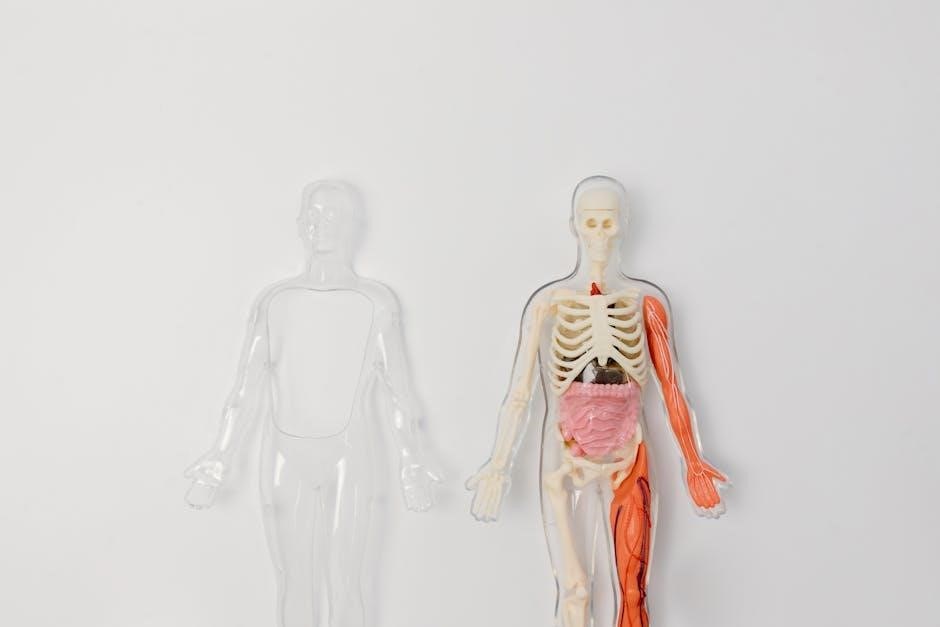
Digital and Multimedia Resources
The 13th Edition offers interactive 3D models, video tutorials, and online quizzes to enhance learning. These resources provide visual and practical aids for mastering anatomy and physiology concepts.
They support self-paced study and reinforce lab manual content effectively.
5.1 Interactive 3D Models and Simulations
The 13th Edition includes interactive 3D models that allow students to explore anatomical structures in detail. These models enable users to rotate, zoom, and label parts, enhancing visualization and understanding. Simulations also demonstrate physiological processes, such as muscle contractions or blood flow, making complex concepts more accessible. These tools are accessible online and via mobile devices, providing flexible learning opportunities for students to engage with material anytime, anywhere. They are particularly useful for visual learners and those needing additional support.
5.2 Video Tutorials and Demonstrations
The 13th Edition features video tutorials that provide step-by-step guidance for laboratory procedures and complex physiological processes. These videos include dissections, microscopy techniques, and experiments, allowing students to review procedures before lab sessions. Demonstrations also cover clinical applications, such as patient exams and diagnostic tests, to bridge anatomical knowledge with real-world scenarios. The videos are accessible online, offering a flexible learning tool that complements the manual and enhances understanding of key concepts.
5.3 Online Quizzes and Assessment Tools
The 13th Edition includes online quizzes and assessment tools to reinforce learning and track progress. These resources help students self-assess their understanding of anatomical and physiological concepts. Interactive questions cover a range of topics, from cellular structure to organ system functions. Immediate feedback and explanations enhance comprehension, while progress tracking allows students to identify areas for further study. These tools integrate seamlessly with the lab manual, providing a comprehensive learning experience.
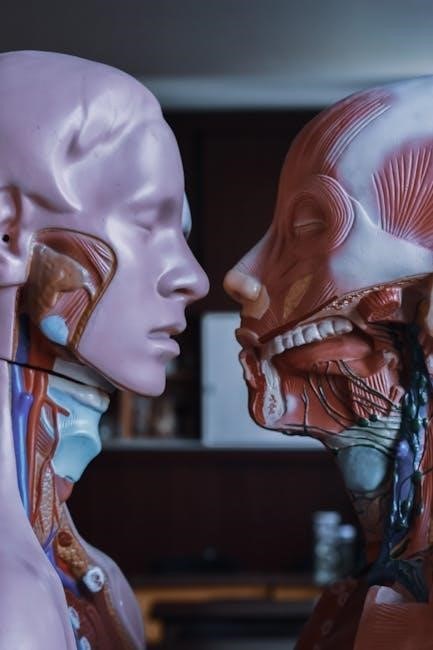
Using the Manual Effectively
Maximize learning with the 13th Edition by engaging in hands-on activities, setting clear goals, and utilizing interactive features like 3D models and quizzes for a deeper understanding.
6.1 Study Tips for Anatomy and Physiology
Master anatomy and physiology by engaging in active learning, using visuals like diagrams and 3D models. Practice labeling structures and reviewing clinical scenarios regularly. Focus on understanding physiological processes rather than just memorizing facts. Utilize the manual’s review sheets and critical thinking exercises to reinforce concepts. Integrate digital resources, such as quizzes and simulations, to enhance retention and prepare for assessments effectively;
6.2 Time Management Strategies
Effective time management is crucial for mastering anatomy and physiology. Prioritize tasks, focusing on complex topics first. Allocate specific time blocks for lab activities, self-study, and review. Utilize the manual’s digital resources, such as quizzes and simulations, to optimize learning efficiency. Regularly review notes and practice labeling diagrams to reinforce retention. Balance hands-on experiments with theoretical study to ensure comprehensive understanding and meet deadlines successfully.
6.3 Collaborative Learning Opportunities
The 13th Edition encourages group activities and peer-to-peer learning. Students can work together on hands-on experiments, share insights, and discuss complex concepts. Digital resources, such as interactive simulations, facilitate collaborative study sessions. Group discussions and lab partnerships enhance understanding and retention, while shared problem-solving fosters critical thinking. Collaborative learning not only strengthens knowledge but also builds communication and teamwork skills essential for success in anatomy and physiology.
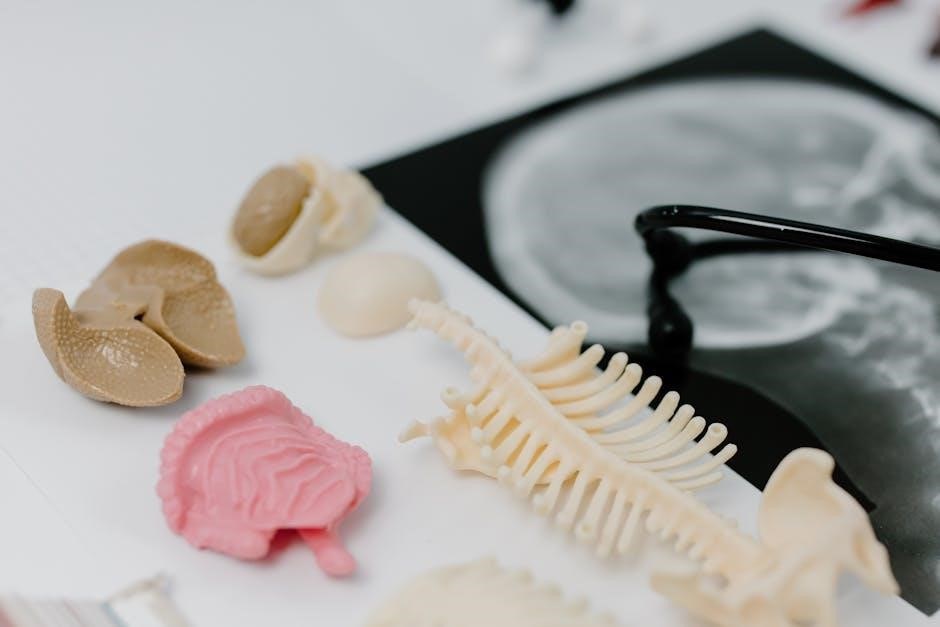
The Role of Lab Manuals in Anatomy and Physiology Education
Laboratory manuals like the 13th Edition provide hands-on experience, enhancing understanding of anatomical structures and physiological processes. They serve as practical guides, making complex topics accessible through interactive resources and real-world applications.
7.1 Benefits of Hands-On Learning
Hands-on learning through lab manuals like the 13th Edition enhances engagement and retention by allowing students to apply theoretical knowledge. It fosters practical skills, critical thinking, and problem-solving, making complex anatomy and physiology concepts more accessible. Interactive activities and real-world applications bridge the gap between textbook learning and clinical practice, preparing students for future careers in healthcare and scientific fields with a deeper understanding of human structures and functions.
7.2 Comparison with Traditional Textbooks
The 13th Edition lab manual differs from traditional textbooks by emphasizing interactive, hands-on learning over passive reading. While textbooks focus on theoretical knowledge, this manual integrates practical exercises, 3D models, and real-world applications. Its visual and tactile approach enhances comprehension of complex anatomical and physiological concepts, making it a more engaging and effective tool for active learning and skill development compared to static, text-heavy resources.
7.3 Impact on Student Performance and Engagement
The 13th Edition lab manual significantly enhances student performance and engagement by providing interactive 3D models, critical thinking exercises, and hands-on activities. These features improve understanding of complex anatomical and physiological concepts. The integration with digital tools like Mastering A&P further supports personalized learning, leading to better academic outcomes and increased motivation among students.

Authors and Contributors
The Human Anatomy and Physiology Lab Manual, 13th Edition, is authored by Elaine N. Marieb and Lori A. Smith, with contributions from expert reviewers and advisors.
8.1 Elaine N. Marieb and Lori A. Smith
Elaine N. Marieb and Lori A. Smith are renowned authors in anatomy and physiology education. Marieb, a dedicated educator, is celebrated for her clear, student-focused writing style. Smith brings extensive laboratory teaching experience, ensuring practical, hands-on learning. Together, they crafted the 13th Edition Lab Manual, blending cutting-edge visuals, clinical applications, and critical thinking exercises to enhance student understanding and engagement in anatomy and physiology studies.
8.2 Expert Reviewers and Advisors
The 13th Edition benefits from expert reviewers and advisors who ensure accuracy and relevance. Their contributions refine content, enhance clarity, and align with educational standards. Reviewers from diverse anatomical and physiological expertise provide feedback, enriching the manual’s depth. Their insights are invaluable, helping to refine visuals, exercises, and clinical applications, making the manual a trusted resource for students and educators in anatomy and physiology education.
8.3 Acknowledgments and Dedication
The 13th Edition acknowledges the invaluable contributions of expert reviewers, advisors, and educators. Their feedback and insights have significantly enhanced the manual’s quality and relevance. The authors extend gratitude to all who supported this project, dedicating their work to students and instructors worldwide. This edition is a testament to collaborative effort, aiming to inspire a deeper understanding and appreciation of human anatomy and physiology.
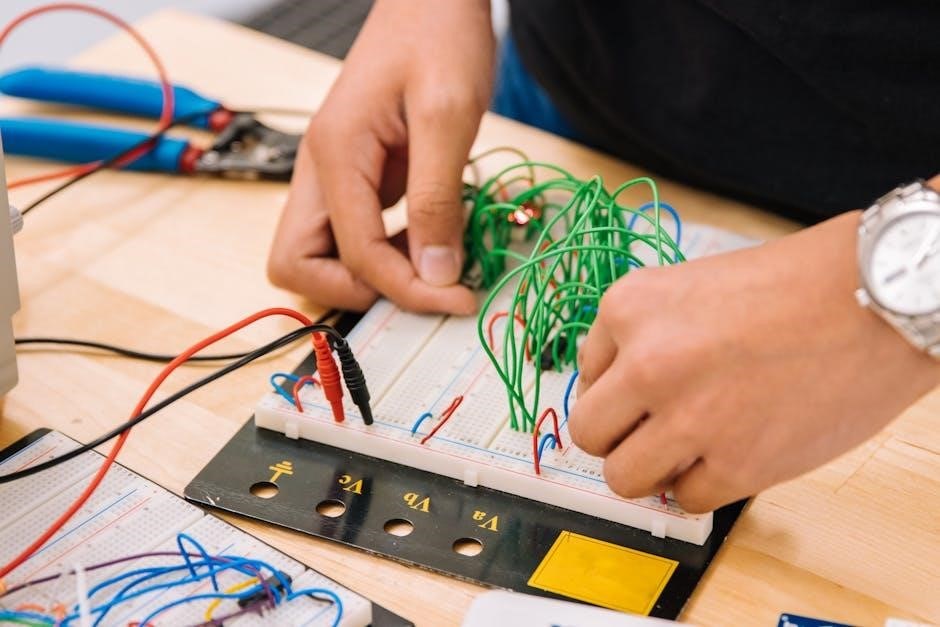
Accessing the 13th Edition PDF
The 13th Edition is available as a PDF through legal sources like Pearson’s official website. Purchase, subscription, or free trial options are offered for easy access.
9.1 Legal Sources for the PDF
The Human Anatomy and Physiology Lab Manual, 13th Edition PDF can be legally accessed through reputable sources like Pearson, McGraw-Hill, and Amazon. Purchase options include new or used copies, while rentals offer cost-effective solutions. Digital versions are available through official publishers or authorized sellers, ensuring authenticity and quality. Always verify the seller’s credibility to avoid unauthorized or pirated content, and support authors by purchasing through legitimate channels.
9.2 Subscription and Purchase Options
The Human Anatomy and Physiology Lab Manual, 13th Edition PDF can be purchased or subscribed to through platforms like Pearson, Amazon, or McGraw-Hill. Options include buying new or used copies, renting for a semester, or accessing digital versions. Subscriptions often bundle the manual with online resources, offering convenience for students. Digital subscriptions provide flexible access across devices, while physical copies remain a popular choice for hands-on learners. Prices vary based on format and retailer.
9.3 Free Trials and Preview Versions
Free trials and preview versions of the Human Anatomy and Physiology Lab Manual, 13th Edition PDF are available on platforms like Pearson and McGraw-Hill. These offerings allow students to explore select chapters or features before purchasing. Preview versions provide glimpses of updated content, while free trials enable temporary access to digital resources. This option is ideal for students wishing to evaluate the manual’s suitability for their coursework before committing to a purchase.

Future Editions and Updates
Future editions will integrate advanced digital tools, updated anatomical discoveries, and expanded clinical correlations, ensuring the manual remains a leading resource for anatomy and physiology education.
10.1 Anticipated Changes in Upcoming Editions
Future editions of the lab manual are expected to incorporate advanced digital tools, expanded clinical correlations, and updated anatomical content. Enhanced multimedia resources, including 3D simulations, will improve engagement. The integration of real-time feedback mechanisms and adaptive learning features is also anticipated. These updates aim to align with evolving educational needs and student preferences, ensuring the manual remains a cutting-edge resource for anatomy and physiology education.
10.2 User Feedback and Suggestions
Users have praised the manual for its clarity and practicality, with suggestions for more interactive simulations and real-time feedback tools. Feedback highlights the need for expanded clinical scenarios and additional 3D models. Publishers encourage input to refine content and enhance usability, ensuring future editions meet evolving educational demands and student preferences effectively.
10.3 Advancements in Anatomy and Physiology Education
The 13th Edition integrates cutting-edge educational advancements, including interactive 3D models and real-time simulations, to enhance learning. Digital tools now support personalized learning experiences, allowing students to explore complex anatomical structures and physiological processes dynamically. These innovations reflect the growing emphasis on technology-driven education, ensuring the manual remains a leader in anatomy and physiology training.
